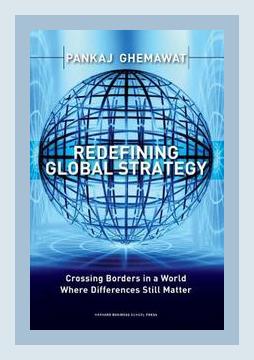Business StrategyInternational Business
Introduction
Pankaj Ghemawat’s book, “Redefining Global Strategy,” delves deeply into the complexities of globalization and cross-border strategy in a world where national boundaries and cultural differences still significantly influence business outcomes. The author argues that while the world is increasingly interconnected, it remains far from fully globalized. This distinction is crucial for businesses aiming to navigate the complexities of international markets.
1. The Myth of Globalization
Major Point:
Ghemawat challenges the common notion of a “flat” world, popularized by authors like Thomas Friedman. He argues that despite advances in technology and communication, significant differences remain between countries in terms of culture, politics, economics, and geography.
Concrete Examples:
- He highlights that only a small percentage of all human communication, trade, and investments cross borders, illustrating the persistent relevance of national boundaries.
Actionable Advice:
Action: Companies should avoid assuming that strategies that work domestically will apply universally. Conduct detailed market research and adapt strategies to align with local conditions.
2. The CAGE Framework
Major Point:
Ghemawat introduces the CAGE (Cultural, Administrative, Geographic, Economic) framework to help businesses assess and strategize around differences between countries.
Concrete Examples:
- Cultural: Language barriers and differing consumer preferences.
- Administrative: Variations in regulatory environments, such as differing legal systems.
- Geographic: Physical distance affecting transportation costs and logistics.
- Economic: Differences in income levels and cost structures.
Actionable Advice:
Action: Apply the CAGE framework to systematically evaluate new markets. For instance, when entering a new country, use the framework to identify potential barriers and opportunities specific to that market.
3. AAA Strategy
Major Point:
To effectively navigate global markets, Ghemawat outlines three primary strategies: Adaptation, Aggregation, and Arbitrage.
Concrete Examples:
- Adaptation: McDonald’s localizing its menu in India to include vegetarian options.
- Aggregation: LG Electronics employing standardized manufacturing processes across multiple countries to achieve economies of scale.
- Arbitrage: Companies like Apple taking advantage of cost differentials by outsourcing production to countries with lower labor costs.
Actionable Advice:
Action: Choose the appropriate AAA strategy based on the target market’s characteristics. For example, focus on adaptation when entering culturally distinct markets like Japan or India.
4. Realizing Benefits from Cross-Border Integration
Major Point:
Ghemawat emphasizes the importance of balancing global integration with local responsiveness to achieve competitive advantage.
Concrete Examples:
- Toyota’s success in the U.S. market due to balancing global efficiency with adaptations to meet local tastes and regulatory requirements.
Actionable Advice:
Action: Align your global strategy to ensure that both global integration and local responsiveness are achieved. For example, maintain a core brand proposition globally while allowing for local product variations.
5. The Evolving Nature of Globalization
Major Point:
Ghemawat observes that globalization is a dynamic process, influenced by technological advancements, political shifts, and economic changes.
Concrete Examples:
- The rise of digital platforms like Alibaba facilitating cross-border e-commerce.
- Changing trade policies affecting global supply chains, such as Brexit.
Actionable Advice:
Action: Stay informed about global trends and be prepared to adapt your strategy as the international landscape evolves. For instance, develop flexible supply chains that can quickly adjust to new trade regulations.
6. Institutional Voids and Emerging Markets
Major Point:
In many emerging markets, formal institutions that underpin market economies are weak or absent, creating “institutional voids.”
Concrete Examples:
- The lack of transparent legal systems in some countries leading to corruption and business risks.
- Nigeria’s informal economy, which presents both challenges and opportunities for foreign firms.
Actionable Advice:
Action: Identify and bridge institutional voids when entering emerging markets. For example, build trust through strong local partnerships where legal systems are unreliable.
7. Cross-Border Mergers and Acquisitions
Major Point:
Ghemawat discusses the complexities and potential pitfalls of cross-border mergers and acquisitions, noting that many fail due to cultural and operational clashes.
Concrete Examples:
- The Daimler-Benz and Chrysler merger, which experienced significant cultural integration issues leading to its eventual failure.
Actionable Advice:
Action: Conduct thorough due diligence and develop robust post-merger integration plans that address cultural, operational, and strategic differences. Engage with local leaders and stakeholders early in the process.
8. Role of Global Leadership
Major Point:
Effective global leadership is essential for navigating the challenges of international business, as leaders must be adept at managing diverse teams across different cultures.
Concrete Examples:
- Procter & Gamble’s leadership program, which emphasizes cross-cultural training for its managers.
Actionable Advice:
Action: Invest in leadership development programs that focus on cross-cultural competencies and international business skills. Encourage rotation assignments to expose leaders to various markets and cultural contexts.
9. The Downside of Global Connectedness
Major Point:
Ghemawat warns against over-reliance on global connectivity, which can expose companies to systemic risks such as global financial crises or supply chain disruptions.
Concrete Examples:
- The 2008 financial crisis, which had ripple effects across global markets.
- The COVID-19 pandemic disrupting global supply chains and exposing vulnerabilities.
Actionable Advice:
Action: Build resilient strategies to mitigate global risks. For instance, diversify supply chains to reduce dependence on a single region or supplier.
Conclusion
In “Redefining Global Strategy,” Pankaj Ghemawat offers a nuanced view of globalization, stressing that while the world is interconnected, significant differences between countries must be carefully navigated. By employing frameworks like CAGE and strategic approaches like AAA, businesses can better tailor their strategies to succeed in diverse international markets. Leaders should also focus on developing cross-cultural competencies and be prepared to adapt to a changing global landscape, ensuring their organizations can thrive despite the persistent complexities of operating across borders.
